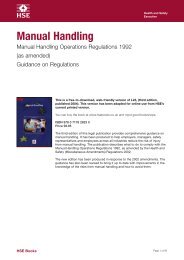Making Companies Safe - what works? (CCA ... - Unite the Union
Making Companies Safe - what works? (CCA ... - Unite the Union
Making Companies Safe - what works? (CCA ... - Unite the Union
You also want an ePaper? Increase the reach of your titles
YUMPU automatically turns print PDFs into web optimized ePapers that Google loves.
Chapter Four<br />
Conclusion<br />
There is very strong evidence from <strong>the</strong> international and national empirical research that <strong>the</strong><br />
introduction or threat of new legislation is a key driver of behavioural change, and that<br />
employers are unlikely to introduce measures that are not required of <strong>the</strong>m by law. Therefore<br />
<strong>the</strong> recent reversals of government and HSC policies to develop and implement new<br />
legislation that would address current gaps or flaws in <strong>the</strong> regulatory framework contradict<br />
independently conducted international and national research.<br />
In addition, <strong>the</strong> HSC has decided to engage with <strong>the</strong> Corporate Social Responsibility<br />
movement as a substitute for legal regulation 1 at a time when serious questions are being<br />
raised by many stakeholders about <strong>the</strong> ability of CSR to deliver meaningful and sustained<br />
improvements, with <strong>the</strong>se groups arguing that CSR should only be seen as a stop-gap on <strong>the</strong><br />
road towards legal regulation.<br />
The U-turns in relation to both directors’ duties and worker participation and consultation are<br />
particularly worrying for two reasons. First, as stated, <strong>the</strong>re is general evidence that<br />
voluntarism does not work. Second, <strong>the</strong>re is strong and specific evidence to suggest that both<br />
of <strong>the</strong>se factors – namely, board level commitment and workforce participation – are crucial<br />
to improving OHS performance, and that <strong>the</strong> imposition of legal duties and additional rights,<br />
for directors and workers respectively, and <strong>the</strong> enforcement of those duties and rights,<br />
would be effective means of reducing injuries and ill-health in <strong>the</strong> workplace.<br />
It is uncertain whe<strong>the</strong>r HSC’s stance on <strong>the</strong>se two issues reflects <strong>the</strong> position of <strong>the</strong> Better<br />
Regulation Task Force (BRTF) which has produced a number of reports critical of any knee jerk<br />
response to <strong>the</strong> ‘automatic’ use of law as a regulatory tool. In a foreward of a recent report,<br />
called ‘Imaginative Regulation’, <strong>the</strong> BRTF states that: “arguably <strong>the</strong> most important of all <strong>the</strong><br />
options discussed in <strong>the</strong>ir report is <strong>the</strong> option not to intervene at all.” The report also goes<br />
onto say:<br />
“Prescriptive state regulation, which we call ‘classic regulation’ in this report, is<br />
where a law is passed to tell people <strong>what</strong> to do or <strong>what</strong> not to do. This may be<br />
primary legislation – where <strong>the</strong>re is an Act of Parliament – or secondary<br />
legislation, often (confusingly) known as ‘regulations’.……<br />
Classic regulation is <strong>the</strong> traditional way for <strong>the</strong> State to seek to change<br />
behaviour. If <strong>the</strong>re seems to be a need to intervene in a market; a new health risk<br />
needs to be addressed; <strong>the</strong>re has been an accident or disaster and “something<br />
must be done”, <strong>the</strong> first thought is usually “we need to regulate” We want to<br />
stop this from being <strong>the</strong> first thought. Too often this first thought becomes <strong>the</strong><br />
only option. We want Departments to choose <strong>the</strong> best way of solving <strong>the</strong>ir<br />
problem. Classic regulation may prove to be <strong>the</strong> best way; but equally it<br />
may not.” 2<br />
However, <strong>the</strong> BRTF does take a nuanced view in that it does make clear that legal regulation<br />
has, in many cases, its advantages, and that <strong>the</strong> important thing is to consider whe<strong>the</strong>r <strong>the</strong>re<br />
are any alternatives to legal regulation ra<strong>the</strong>r than simply ruling it out. 3 However, <strong>the</strong> HSE<br />
appears to be unaware of this and in its report to <strong>the</strong> Commission – which was accepted by<br />
<strong>the</strong>m – <strong>the</strong> HSE stated:<br />
“In considering <strong>the</strong> way forward, <strong>the</strong> Commission may wish to take note of <strong>the</strong><br />
Better Regulation Task Force’s guidance on policy development which indicates<br />
33
















